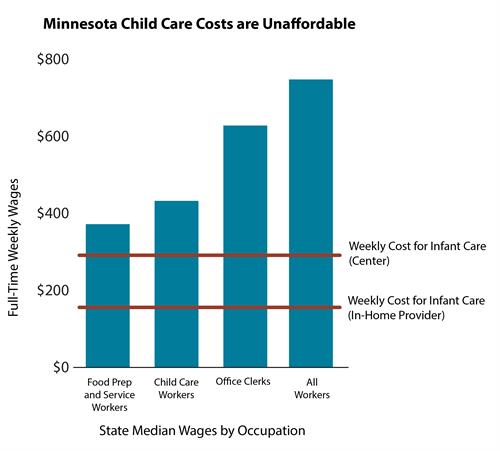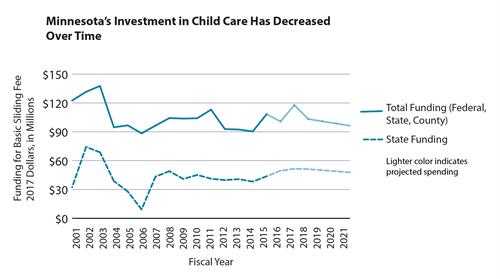Affordable, dependable child care allows children to thrive, parents to get to work or school, and employers to fill crucial job openings. For too many Minnesota families, reliable child care is out of reach due to child care costs that can rival college tuition fees, long waiting lists for child care assistance, and funding levels for Basic Sliding Fee Child Care Assistance that have yet to recover from big cuts made more than a decade ago.
Basic Sliding Fee makes child care more affordable by reducing the monthly costs of child care for about 8,500 families across the state. Basic Sliding Fee covers infants and children up to age 12 for the hours parents need to work. The state’s funding for Basic Sliding Fee has decreased by 25 percent since FY 2003 when inflation is taken into account.[1] During roughly the same time period, the waiting list for Basic Sliding Fee has grown to include more than 5,000 families,[2] and the number of families able to access Basic Sliding Fee decreased by 3,700. Participation decreased by about the same amounts in Greater Minnesota and in the seven-county metro area.[3] A renewed investment would allow more families to choose affordable, reliable care for their children.
Basic Sliding Fee is part of Minnesota’s Child Care Assistance Program. When a child care provider accepts a family participating in Child Care Assistance, the state pays a portion of the child care costs and the family pays an income-based co-payment. Today, the maximum payment only covers the rates charged by about 30 percent of child care providers.[4] That means many providers that accept Child Care Assistance families do so at a loss, or require parents to make up the difference on top of their existing co-payments. This exacerbates the difficulty parents have in finding affordable care. Reimbursement rates that better reflect actual costs would give families more options to find the care that meets their needs.
The strength of the state’s economic future depends on greater participation of Minnesotans in the economy. With a tightening labor market and more people retiring from the workforce, Minnesota can’t afford to leave working parents on the sidelines because they lack access to affordable child care. Investing in Basic Sliding Fee would be an important step.
Investing in Basic Sliding Fee Will Make Child Care Affordable for More Minnesota Families

Child care can be one of the largest expenses that families with children face. The average annual cost of infant care at child care centers in Minnesota in 2015 was $14,826. The cost for an infant at an in-home care provider was $8,033.[5]
These costs are unsustainable for low- and moderate-income families. In 2009, a Wilder Research survey of households paying for child care found that families earning less than $20,000 spent an average of 29 percent of their incomes on child care. Households earning between $20,000 and $45,000 spent 18 percent of their incomes on child care.[6]
Such high costs mean that many parents rely on a patchwork of informal care arrangements – 35 percent of low-income households in Minnesota reported that they felt they “had to take whatever arrangement they could get.”[7] In these situations, it is difficult to maintain consistent care; the relative who watches a child may get sick, or a reliable neighbor may move away. A lack of consistent child care can make it difficult for a parent to get to class or their job, and the disruption can also have a negative impact on their children. Frequent changes in care arrangements are correlated with poor acquisition of school readiness skills, bullying behavior and acting out.[8]
Basic Sliding Fee helps children stay in stable care. Families choose their child care provider for the hours needed while parents are working or at school, and parents make a co-payment that increases as their income rises. The state fills in the gap between the parent’s co-payment and the provider’s charges for care, up to a maximum rate.
Families can become eligible for Basic Sliding Fee if their incomes are below 47 percent of the state’s median income for their household size. Once enrolled, families remain eligible until their incomes reach 67 percent of the state median income. For example, a household of four can become eligible for Basic Sliding Fee with an income of about $44,000 or less. This household would remain eligible until they earn about $63,000.[9] This means that parents won’t suddenly lose their access to child care assistance if they work some additional hours or get a small raise at work.
Importantly, Basic Sliding Fee covers children from infancy through age 12. About 37 percent of children whose families receive Child Care Assistance are school-aged children ages six or older.[10] With Basic Sliding Fee, parents don’t need to worry if their work hours don’t match their child’s school hours, or what they will do for care over the summer.
A Higher Provider Rate Will Increase Parental Choice
Deterioration in the state’s payments to providers through Child Care Assistance limits families’ child care options. State reimbursement rates are based on what child care providers charge in each county. If the combined parent co-payment and state contribution do not cover the rates charged by a provider, either parents can be asked to pay more, the provider needs to fill in the gap with other resources, or that provider will serve families with Child Care Assistance at a financial loss.
Current reimbursement rates only cover the rates charged by about 30 percent of child care providers.[11] That’s a dramatic decline from 2003, when about 80 percent of providers’ rates were covered.[12] The low reimbursement rates limit the number of providers available to families. In addition, the number of licensed child care providers in Minnesota has declined by about 20 percent since 2005.[13] In other words, parents are now choosing from a significantly smaller pool of providers.
Many child care providers are small businesses that eke by on razor-thin profit margins. With such intense pressure, providers may simply choose not to accept families participating in Child Care Assistance. An increase to the state’s reimbursement rates would give parents all over Minnesota more options as they search for a stable environment in which their children can thrive by allowing more providers to accept such families without taking a financial loss.
Funding for Basic Sliding Fee has Dropped Dramatically

State funding for Basic Sliding Fee has dropped by 25 percent since FY 2003, adjusted for inflation.[14] Massive cuts to Child Care Assistance totaling $250 million from FY 2004 to FY 2007 were passed in the 2003 and 2005 Legislative Sessions. Significant policy changes made in these years weakened Child Care Assistance. Policymakers lowered the income families could earn and qualify for assistance by about a third, increased family co-payments and froze provider rates.
Basic Sliding Fee funding has never recovered. Policymakers made an important move to reverse this trend in 2015 by increasing funding by $10 million in FY 2016-17. However, state funding for Basic Sliding Fee will be $52 million in FY 2017, compared to $69 million in FY 2003 in inflation-adjusted dollars.[15]
Federal dollars – and a small county contribution of about $3 million per year – also fund Basic Sliding Fee, but total spending on Basic Sliding Fee is projected to drop from an inflation-adjusted $138 million in FY 2003 to $96 million in FY 2021.[16] That is a decrease of 30 percent.
This disinvestment and its accompanying policy changes have had real consequences for Minnesota families. Today, 4,000 fewer families access affordable care through Basic Sliding Fee than in FY 2003, even though the need for affordable care is as strong as ever. The loss of access has been split nearly evenly between Greater Minnesota and the Twin Cities metro area. More than 5,000 families are on waiting lists for Basic Sliding Fee, and thousands of other families are eligible but not on waiting lists.[17]
Ultimately, the funding shortfall means that fewer children are in stable care, fewer providers are able to give parents the help they need, and more parents struggle to fit child care into their budgets. In today’s tight labor market, we can’t afford to have Minnesotans unable to go to work because of lack of affordable child care. The time is right to take steps so that families can build a better future.
Today’s Child Care is Building Tomorrow’s Minnesota
Affordable child care is a crucial building block of family economic security and our future economic success as a state. This legislative session, Minnesota has the opportunity to provide budget-strapped families with vital access to affordable child care by boosting funding for Basic Sliding Fee. This investment would echo into the next generation as children benefit from having safe, consistent and nurturing environments to grow and thrive. Employers would have an easier time filling crucial positions with workers who would not need to worry about reliable care for their kids. In other words, a strong investment in Basic Sliding Fee will help all boats rise.
By Ben Horowitz
[1] Minnesota Budget Project analysis of Minnesota Department of Human Services Background Data Tables for November 2016 Forecast. This analysis takes inflation into account. Child Care Assistance Program: Number of Families on the Basic Sliding Fee Waiting List, January 2016.
[2] Minnesota Department of Human Services, Child Care Assistance Program: Number of Families on the Basic Sliding Fee Waiting List, October 2016.
[3] Minnesota Budget Project analysis of Minnesota Department of Human Services data on Basic Sliding Fee enrollment by county.
[4] Minnesota Department of Human Services, Minnesota Child Care Assistance Program: State Fiscal Year 2015 Family Profile, March 2016.
[5] Child Care Aware of America and Child Care Aware of Minnesota, State Child Care Facts in the State of Minnesota, December 2016.
[6] Wilder Research, Child Care Use in Minnesota, November 2010.
[7] Wilder Research.
[8] Urban Institute, The Negative Effects of Instability on Child Development: A Research Synthesis, September 2013.
[9] Minnesota Department of Human Services, Minnesota Child Care Assistance Copayment Schedules.
[10] Minnesota Department of Human Services, Minnesota Child Care Assistance Program: State Fiscal Year 2015 Family Profile.
[11] Minnesota Department of Human Services, Minnesota Child Care Assistance Program: State Fiscal Year 2015 Family Profile.
[12] Minnesota Budget Project, The Lost Decade: Taking a Closer Look at Minnesota’s Public Investments in the 2000s, December 2008.
[13] Minnesota Budget Project analysis of Minnesota Department of Human Services data on child care provider licenses.
[14] Minnesota Budget Project analysis of Background Data Tables for November 2016 Forecast.
[15] Minnesota Budget Project analysis of Background Data Tables for November 2016 Forecast.
[16] In FY 2017 dollars.
[17] Minnesota Management and Budget, Consolidated Fiscal Note for SF 695-1A, April 2015.